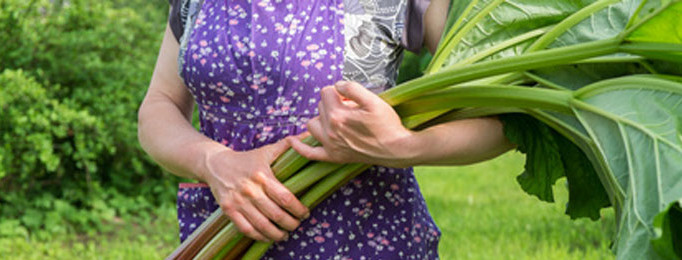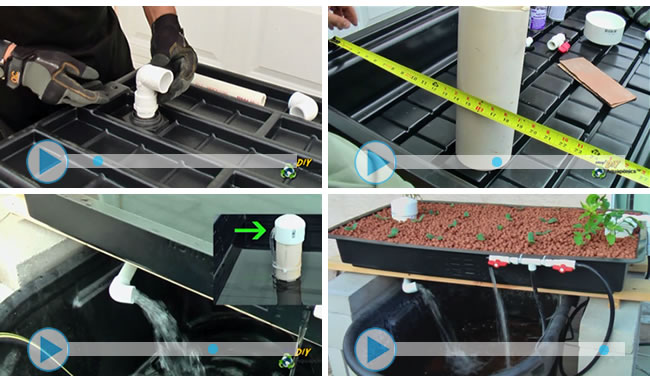Looking for a carefree fruit crop to add to the garden? Then look no further. Assuming you have a cool winter and a moist cooler garden spot available in summer, rhubarb is a perfect tasty perennial to add to your garden.
Rhubarb: Fruit or Vegetable?
Though technically not a fruit, rhubarb (Rheum rhabarbarum) is most often eaten as a fruit or a tart condiment. It is classified as a vegetable throughout most of the world, however, in the United States it was classified as a fruit in the 1940’s by a US court for the purposes of regulation because it is most often eaten as a fruit in the US.
Great for jams, pies and simple syrups, rhubarb adds a bright tart flavor to any fruit dessert, and is particularly delicious in a strawberry rhubarb pie. Rhubarb leaves contain a number of toxins, including high levels of oxalic acid and should not be eaten.
Rhubarb is a terrific and easy perennial that works very well as a garden border or along the edge of a bed. Simple and delicious, it does not require a great deal of care or attention. However, it will need space to spread its large stalks and leaves, and it will come back and grow larger every year, so be sure to plan plenty of space for it. A mature rhubarb plant can easily spread to three feet across!
Cold Winters and Cool Summers
It does like winter temperatures which dip below 40°F which will help it to produce well in Spring as temperatures warm up, and it should be planted in a cool moist area of the garden for long yielding in summer. It does not tolerate drought, so plant it near a permanent watering site or down-slope from ponds, springs or other sources of continuous moisture.
How to Plant Rhubarb
Plant crowns just below the surface of a loose, loamy soil with good drainage. Crowns should have an inch or two of soil covering them. Press the soil gently but firmly into place over them and water them in well.
You can plant whole plants (look at local farmer’s markets for great choices) through most of the summer so long as they get a good watering in and are able to get well established without drying out. Crowns can be planted in spring when the soil is workable or in fall, so long as the soil has good drainage to avoid water logging. If you have heavy clay soil, consider planting in a raised bed to keep them up out of the wet in rainy climates.
Growing and Harvesting Rhubarb
Rhubarbs from crowns can be cut after two years. Don’t cut back too much too fast on a young plant.
Harvest rhubarb by cutting stalks at the base and removing the leaves. You can begin harvesting rhubarb in Spring and harvest through June and early July, or longer, as long as you never harvest all the stalks, and limit your harvest when cutting to allow the plant enough stalks to survive your cutting. As a general rule, do not harvest stalks less than 10 inches in length. Remember the rhubarb needs enough energy to over-winter.
If your rhubarb is three or more years old, it can begin to put out flower stalks, which will be topped with large flower heads which produce rhubarb seed. The flowers will sap the energy and reduce the production of stalks for eating, so they should be cut off and removed if you intend to continue harvesting the stalks. You can continue to harvest after the rhubarb flowers, but you should remove and discard the flower stalk to prevent the plant putting all its energy into seed production.
Medicinal Uses
Rhubarb root is used in Chinese Traditional Medicine as a laxative and was the first Traditional Chinese Medicine imported to the west from China. It was also used in medieval European and Arabic remedies.
Rhubarb contains anthraquinones including rhein, and emodin, whose glycerides can produce a laxative effect.
In the Kitchen
Use rhubarb by cooking it down and adding sugar or honey to sweeten it. At this point you can strain it for simple syrup and use the pulp for spread, or eat it as compote. Rhubarb can also be cut up raw and cooked in tarts, pies and other dessert type baked goodies.
Most famously, of course it is half the miracle of a strawberry-rhubarb pie where it is cut up raw with strawberries, a little sugar and baked in a pie shell.
It makes a terrific simple syrup. Just cook it until tender with some sweetener of your choice and then strain it and put it in the refrigerator in a mason jar or bottle with a cap. It will keep for several months this way.
Simple syrup makes a tasty addition to a fresh summer kombucha or other refreshing healthy drink. You can use it as you would any other syrup, over pancakes or in dessert recipes.
The cooked rhubarb by iteself is a very popular fruit compote. Still warm, or chilled, and served with fresh vanilla ice cream or yogurt. It sets up very nicely and gets quite thick when chilled. Left over pulp from making simple syrup also makes a great spread for toast or as a topping on granola or cooked rice or other grain dishes. The chill, tart and sweet compliment chicken and poultry nicely. You’ll be surprised at the number of places a chilled rhubarb topping will add a delicious new twist!
Resources
More information at How to Grow Rhubarb: Rhubarb Central




